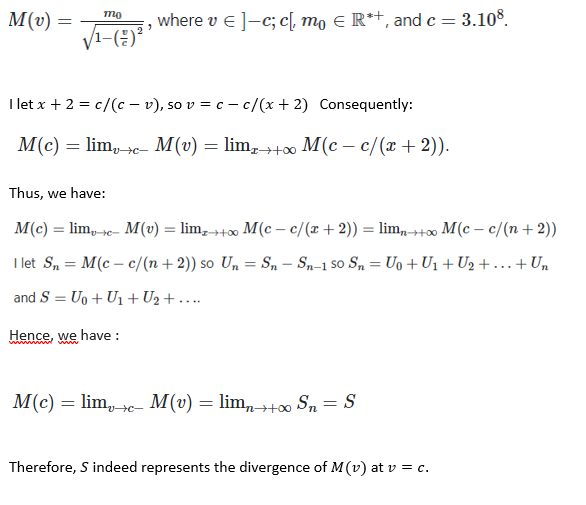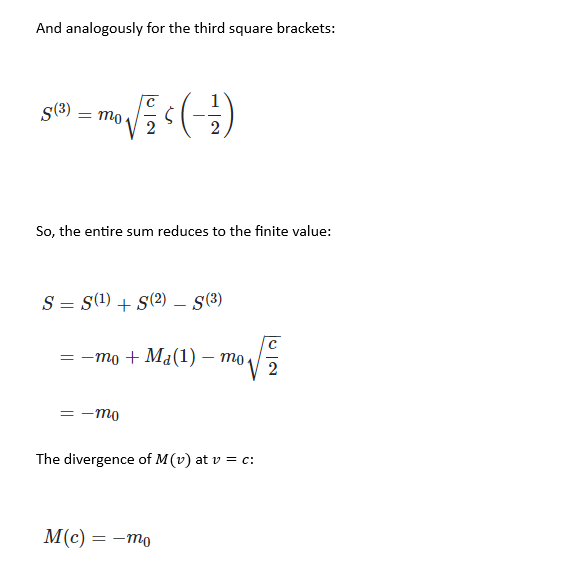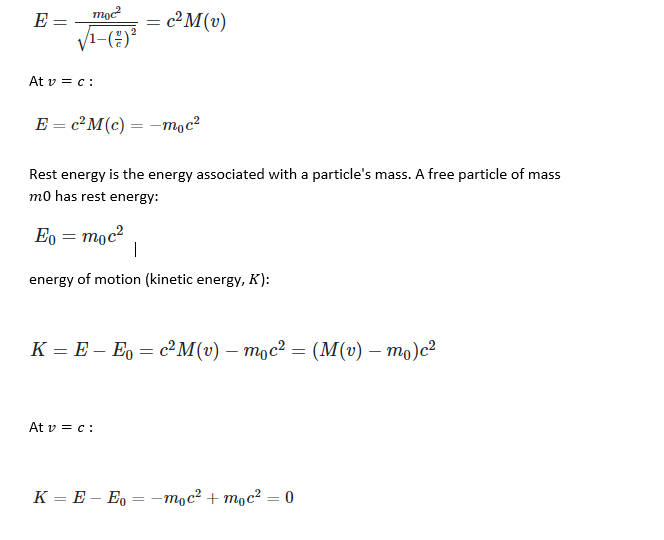

Z.10.46
Senior Members-
Posts
69 -
Joined
-
Last visited
Recent Profile Visitors
The recent visitors block is disabled and is not being shown to other users.
Z.10.46's Achievements

Meson (3/13)
-9
Reputation
-
For your information, even if 'a' and 'b' tend towards infinity, they would still be negligible compared to the infinity of 'n/ln(n)' and 'n+2/ln(n+2)', similar to, for example, 'n' or '-n' being negligible compared to 'n^2'. That's why the ratio π(x)/(x/ln(x)) tends towards 1, even as 'a' and 'b' tend towards infinity. To be more mathematically rigorous, I choose 'a' and 'b' as sequences 'a_k' and 'b_k' with 'n/ln(n)+a_k = N' and '(n+2)/ln(n+2)+b_k = N+1', so '1+n/ln(n)+a_k = (n+2)/ln(n+2)+b_k' Even as 'a_k' and 'b_k' tend towards infinity, the equation remains true, thus indicating the existence of an infinite number of twin prime numbers. If there were not an infinite of twin prime numbers,This equation would admit only one solution for a specific small value of 'n'.
-
yes, but there's nothing preventing transitioning from an approximation to an equality, for instance, if π~3 then I can state that π=3+a with a=π-3, thus If the symbol ~ gives you trouble, then I can even avoid using the integer part to make it an equals sign: if n/ln(n)~N and (n+2)/ln(n+2)~N+1, then n/ln(n)+a=N and (n+2)/ln(n+2)+b=N+1, with a and b being real numbers . So, if there exists an infinity of twin primes, the equation (n+2)/ln(n+2)+b=1+n/ln(n)+a would have a solution where n is very large. If this equation does not have a solution for very large n, then there exists a finite number of twin primes that are less than a specific n..
-
Hello, I have π(x)~x/ln(x), the larger the value of x, the more true this relationship becomes. Suppose I have two very large twin prime numbers, then I would have n/ln(n)~N so E(n/ln(n))=N and (n+2)/ln(n+2)~N+1 so E((n+2)/ln(n+2))=N+1 with Using E to denote the floor function. So, if there exists an infinity of twin primes, the equation E((n+2)/ln(n+2))=1+E(n/ln(n)) would have a solution where n is very large. If this equation does not have a solution with a sufficiently large n, then there are a finite number of twin primes that are less than a specific value of n. This equation is true only if I have infinity = 1 + infinity,So, twin prime numbers are infinite. For your information: When proving the infinitude of prime numbers, it is also demonstrated through this type of equation: q = p1 * p2 * ..{pi}.. * pn + 1/pi. It is stated that the only possibility for q to be an integer based on this equation: infinity = infinity + 1/Pi. Thus, we conclude from this that prime numbers are infinite. And similarly, to demonstrate an infinity of twin primes, I also use the equation infinity = 1 + infinity.
-
What is the mathematical equation in 2D and 3D for your body? Is there a mathematician in our world who could find the mathematical equation in 2D and 3D for their own body? For your information, 2D refers to surface equations, and 3D refers to volume equations. This passage is just for laughter and to encourage participants to try finding the equation for their own body: It's amusing that no mathematician has thought of writing their own body equation, who knows perhaps this equation hides a great mathematical secret.😀 Some legends about the city of Atlantis mention that the foundation of their highly advanced civilization, far more advanced than ours, lay in the discovery of these equations of the human body...😉 It's a buzz that can be noticed by many people, even those who aren't mathematicians. If a mathematician could find the equation of their body, it would create a significant buzz. They could gain notoriety and might even be paid by celebrities and wealthy individuals to write their body equations as well...🤑
-
Yes, but they have a total negative energy -m0c^2. That can explain dark matter or dark energy, as we can see its negative energy effect after this transformation by this phenomenon...
- 5 replies
-
-3
-
Hello , The present theory explores the behavior of the expression of relative mass M(v) with respect to the speed of light (v=c)\ and suggests that dark matter or dark energy could be composed of ordinary particles with mass that have reached the speed of light. The theory delves into a mathematical analysis of the series representing the relative mass function, M(v), and discusses its divergence at v=c, drawing parallels with the regularization of the Casimir effect using the Riemann zeta function, which gives M(c)=-M(0) at v=c. It proposes the existence of a natural phenomenon that accelerates ordinary matter with mass to the speed of light and transforms it into dark matter or dark energy with negative relative mass and finite energy. 1.Representation of the Divergence of Relative Mass at v=c: Consider the function of Relative 2.Application of zeta function regularization on the divergence of relative mass at : You can just separate off the divergent part of and define it via zeta function regularization. Define: 4.Representation of the Divergence of Relative energy at v=c: Due to the definition of the energy-momentum four-vector, in particular its time coordinate, we end up with the expression of the total energy of the particle in the laboratory reference frame, that with respect to which the particle is animated with the speed v because the energy depends on the frame of reference in which it is calculated!) in the form of: If we interpret its results, there may exist particles with a mass m0 and a negative relative mass -m0, having a negative total energy and a positive rest energy, along with zero kinetic energy. These particles could be generated by a physical phenomenon that accelerates particles with mass to the speed of light and could be linked to dark energy or dark matter. 3.Analogy of the theory with Casmir effect: Here is an example of using regularization via the zeta function in the Casimir effect: Mathematical calculations lead to the famous divergent series 1+2+3+4\ldots However, the physical results do not correspond to infinite values for the energy of the moving plates. To resolve this issue, we applied regularization through the Riemann zeta function. Eventually, we obtain a finite value of -1/12 for the divergent series1+2+3+4\ldots and this result provides a good explanation for the Casimir effect. In analogy with the Casimir effect, it is possible that the value -M(0) obtained from the divergent series representing the relative mass at v=c, U0+U1+U2+U3..., has a physical meaning to explain 95% of the missing energy in the universe. Hence, my hypothesis suggests the existence of a natural phenomenon that accelerates ordinary matter with mass to the speed of light and transforms it into dark matter or dark energy with negative relative mass and finite energy. Could you please point out any possible errors in this new theory? The issue with the unit of measurement has been resolved.😀
- 5 replies
-
-2
-
To further support my argument, I give an example with f(x) and g(y), where f(x)=x and g(y)=1/y. I set f(x)=g(y), so I have x=1/y, which is true for any real x and y, even if I set y=0, and I get x=infinity. This equality remains valid even if x is no longer a number and equals infinity because I have infinity=1/0. Next, with f(x) and g(v), where f(x)=x+2 and g(v)=1/(c-v). I set f(x)=g(v), so I have x+2=1/(c-v), which is true for any real x and v, even if I set v=c, and I get x+2=infinity. This equality remains valid even if x+2 is no longer a number and equals infinity because I have infinity=1/0. Therefore, at v=c, I have x+2=1/(c-v)=1/(c-c)=1/0=a/0, where c can have any unit, so x+2 does not have a unit of measurement. I believe this argument is clear. If not, could you please point out any errors in this argument as well?
-
Yes, I know that. I didn't write x+1~x or x^3+x^2+x+1x^3~x^3. I wrote x+2=1/c-v=1/c-c. You notice that I have two different notations, x and c. Why am I choosing ~? It's like saying I have f(x)=g(y)=1/c-c=1/0=a*1/0 with a in R+*. Is it true that 1/(c-v) = 1/(c-c) = 1/0 = a*1/0 with a in R*+ when v=c? If it is true, then I would set x+2=1/c-c=1/0=a/0 with a>0. Therefore, x+2 would not have any unit because even if I change the value of c, I would still have x+2=1/c-c=1/0=a/0, and thus x+2 would not have any unit.
-
Here, I am not just saying that v tends to c, I am saying that v=c, so 1/c-v egal infinity not just tends to infinity , if I set x+2=1/c-v, it's like having the equality infinity+2=infinity I agree with you that it is impossible to do this for a finite quantity but 1/c-v is not finite at v=c and in this case setting x+2=1/c-v is valid without a fixed unit as I demonstrated.
-
Yes, but it's a very solid mathematical proof to justify that x+2 has no unit because the equation x+2=1/c-v is true for any unit of measurement chosen for c, due to the property that infinity=a*infinity, similar to the '1' in the equation 1=c/c which has no unit of measurement as this equation is true for any unit of measurement chosen for c.😁 Could you point out a possible error in this proof?
-
It seems like you are searching for errors where there is no ,mathematical demonstration that is 100% correct. In this discussion, those who understand mathematics and physics very well have highlighted the only flaw in this proof, which is to assume x+2=1/c-v without considering the unit of c. However, the counterproof was very strong because the relationship remains valid regardless of the unit of c, just like the equation c/c=1, which is always true regardless of the unit of c. The discussion about the non-existence of 0 in physics is just off-topic. Here, you are talking about mathematical zero, while I am talking about the non-existence of a physical zero.
- 145 replies
-
-2





